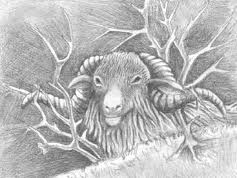 |
| Noah's Rainbow |
Exodus 20:1-17
The Ten Commandments are given by God to Moses on Mount Sinai. They are the substance, the 'stuff', of the Mosaic Covenant. Two weeks ago we recalled the first Covenant, between God and Noah. Last week we heard again the second Covenant between God and Abraham. And now we remember the Covenant that God made with Moses in the desert between Egypt and the Promised Land. This covenant is the most specific covenant that God makes. Noah's covenant had been with all creation; Abraham's covenant was with him and all his descendents, while Moses' Covenant is with a particular people whom God has called to be his own. From the Mosaic covenant forward there is a people called the 'People of God'.
 |
| Abraham's Ram |
2nd Reading
1 Corinthians 1:22-25
"... the Crucified Christ..." is the basic building block of the New Covenant that God makes with the new 'People of God' that the Church is. There is a new covenant, a new Moses, a new people. Now there are four covenants, and four signs: Noah's rainbow, Abraham's ram, Moses' tablets of stone, and Christ crucified. This sign of the new covenant that forms the new people of God is the most radical sign because it is not just a symbol like the others. Rather the sign of the new covenant is a man, sent among us, "to the Jews an obstacle" and "to the pagans madness".
 |
| The Ten Commandments of Moses |
John 2:13-25
The Temple cleansing or purification juxtaposes the concepts of "my Father's house" and "market". The market is something that we are very familiar with in contemporary living. The collapse of the market a few years ago showed us just how unreliable it is in meeting the demands of justice. Jesus does not have a problem with 'the market', but he does have a problem when it takes over "my Father's house". The market can be contaminated with human greed and individual self-interest. For that reason it has no place in the Temple, and the Temple here can be interpreted in three ways – as the Jewish Temple in Jerusalem, the setting for the gospel story; as the Sanctuary that is Jesus' body; and Jesus' body, the Church, in all times and places, including our own time and place. Money and the market are good things, it is what the human heart does with them that contaminates them and makes them contemptible.
Homily Notes
 |
| The Cross of Christ |
Daniel's parents, Betty and Joel (featured on the Trocaire box this year), have been through many traumatic events in their thirty years of married life. By sticking together, even after they were forceably separated, Joel and Betty are creating a future for Daniel. Their covenant to each other, before God, is bearing rich fruit. In the tough and testing times that we are living through here in Ireland, it is by sticking together, and living out our covenants that we will create a future filled with hope for the generations to come.
Homily Notes for the Trocaire Lenten Liturgy Resource
also published in 'Intercom' the monthly Pastoral Resource of the Irish Episcopal Conference
by Fr John Coughlan, CC, Roscommon

No comments:
Post a Comment